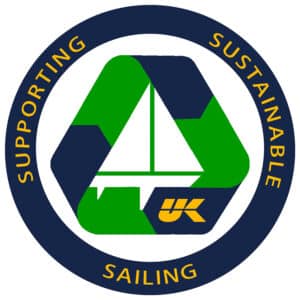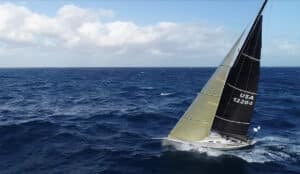The J/109 WHISKEY JACK sailing fast and deep with her A2, which is slightly bigger than the class’s one-design asymmetrical spinnaker. All photos by Guy Nowell.
The J/109 splashed onto race courses around the world in 2004, which is over 15 years ago. They have been strong competitors in one-design and handicap racing because the boats are well rounded and not extreme. The J/109 is also a good family cruising boat; a true all-around design. Updating this venerable 35.75-footer brought together UK Sailmakers Ireland , a J/109 owner in Hong Kong and New Zealand yacht design Kevin Dibley. In this article, UK Sailmakers Ireland’s Barry Hayes tells what was done and how it all worked out.
While living in Hong Kong, I raced the J/109 WHISKEY JACK in class 2. The boats in this rating band are extremely completive and dominated by three A35s as well as Sunfast 3600s, an X-35 and a First 34.7. We had to sail our rear-ends off to do as well as we did.
The owner of WHISKEY JACK wanted to see how he could improve his J/109 to be more competitive. Realizing he probably would have to leave some of the boat’s one-design components in the rear-view mirror, he contacted UK Sailmakers Ireland having seen what we had done with J/109 ratings in Ireland. To get an overall evaluation of the entire boat (including sails, rig, set-up, etc.), I got onto Kevin Dibley. Over more than a few cups of tea, we checked out all aspects of the boat to see where we could improve upwind and down.
We set for ourselves three objectives:
1) increase her upwind boat speed
2) improving her pointing ability and
3) to reduce her IRC rating.
Not a small assignment!
We started by considering how to improve her upwind VMG. We set out to reduce the wetted surface area of the boat while maintaining the waterline as much as we could. To achieve this, we looked at reducing the internal weight in the boat; but we also looked at the external weight and what could be done there.
To get the internal weight out, we replaced as much of the loose furniture as we could with lightweight carbon foam boards from ZLXC. The carbon boards were cut down to match the floorboards and painted in white non-skid. Next, we went to work on the exterior of the boat. We started by replacing the original aluminum mast with one made of carbon manufactured by Axxon Composites. Swapping out for a lighter mast saves us a lot of weight and, importantly, the reduction in tipping weight would keep the boat upright. The set-up of this mast would be exactly the same as a standard J/109 mast apart from one small aspect…the material from which it was made and the masthead crane.
Having reduced the hull and mast weight by a significant 200 kg, we set out to optimize her upwind performance. We started by focusing on a power-to-weight ratio so that the boat would perform at her optimum rating at 8-12 kts, the typical wind speeds in HK. Reducing the 140 % overlapping genoa to nonoverlapping headsails gave a big reduction in her rating, but we then had to make sure she could still perform. The worst thing we could have done was to create a scenario where we left the boat terribly underpowered. But using the “twist” designed headsail that we developed in 2019, we found we were able to achieve the optimum pointing angle and balance upwind. That met one of our objectives. We then added UK Sailmakers carabiners on the headsail luff to make the hoist and drops faster to get the asymmetric to set quicker and stay up longer.
The bigger masthead crane and wider head mainsail can be seen in this photo.
We had made major strides at this point, but we weren’t done yet. We worked further on the balance of the boat while focusing on getting the maximum drive out of the mainsail roach. We ended up increasing the crane width on the mast so we could align the girths on the mainsail. The mainsail maintained its luff curve but increased the J/109 girths, and the head of the mainsail became a lot wider (0.4 m), made possible by the larger masthead crane of the new mast. This was key to reducing drag and increasing the power at the top of the rig. We were able to do this while maintaining the balance of the boat and its increasing pointing ability by adjusting the rake of the mast.
Given the lighter airs in Hong Kong, we designed a deeper running asymmetric with an area of 111m², slightly larger than the J/109 One-Design standard. The new kite, combined with the reduced wetted surface area and a new wider head main, allowed WHISKEY JACK to sail deeper than the other asymmetric boats. She was able to creep away downwind at a lower angles with better speed than her opposition. With the reduction in rating from 1.028 down to 1.019, the boat now enjoyed a massive reduction in rating while increasing her boat speed upwind and down. WHISKEY JACK went on to clean up at this year’s China Coast Regatta in HK.
The owner went on to say after his victory, “The most significant differences in my view were the change to the carbon mast, the new UK Sailmakers Titanium sails and a well-tuned rig with an appropriate mast rake. The boat now is superbly balanced and sails higher and faster than she ever did and she does not heel as much. I can sail the boat flatter than before – that gives the extra height and speed in my view.”



